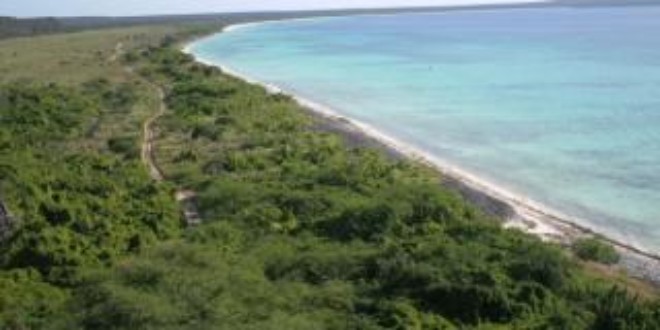Jaragua National Park, famous for housing the world’s tiniest reptile, will itself be in danger if the green light is given to mega-hotel projects instead of ecotourism and sustainable development initiatives, say Dominican ecologists. Tourism interests, focused on large hotels, stress the white-sand beaches and clear waters of this part of the Dominican Republic.
Located in the southwestern province of Pedernales, bordering Haiti, Jaragua National Park is the area of greatest biodiversity in the Antilles. Its 1,374 square kilometres encompass forests, beaches and islands.
Endemic species include the rhinoceros iguana (Cyclura cornuta) and Ricord’s iguana (Cyclura ricordi), which are both threatened. Since November 2002 the park has been one of three core areas in the biosphere designated by UNESCO, along with the Lago Enriquillo and Sierra de Bahoruco parks.
This is where the world’s smallest reptile was discovered, the Jaragua sphaero, or dwarf gecko (Sphaerodactylus ariasae), just 16 millimetres long.
On the beaches of Jaragua park, sea turtles lay their eggs, like the hawksbill (Eretmochelys imbricata) and the leatherback (Dermochelys coriacea), and it is an important habitat to the freshwater turtle, the Hispaniola slider (Trachemys decorata), also endangered.
Aguilas Bay, a pristine seven-kilometre beach on the west coast of the park, has long attracted foreign firms interested in tourism development.
The government is considering several investment proposals. Since April it has been evaluating a plan from a Canadian mining company, whose name has not yet been divulged, to invest 850 million dollars in the construction of two hotels with golf courses in Pedernales, very close to Jaragua Park.
The project would be in Cabo Rojo, a few km from Aguilas Bay, the tourism deputy secretary for the southern zone, José Altagracia Santana, told Tierramérica.
Although it is not part of the park, Cabo Rojo does form part of the same ecosystem and is within the biosphere reserve protected by UNESCO (United Nations Educational, Scientific and Cultural Organisation).
In order to protect the turtles in Cabo Rojo and the park’s beaches, the Jaragua Group, the most active environmental organisation in the area, works to prevent the eggs from being stolen and to stop the capture of the turtles themselves for their prized shells.
But tourism is another story. “The impact of a great number of tourists would not only threaten the endemic species in these areas, but the entire ecosystem, which is unique in the world,” the director of the Jaragua Group, Yvonne Arias, told Tierramérica.
(From ipsnews.net, Dominican Republic, by Valeria Vilardo)
 Ocean Sentry
Ocean Sentry




